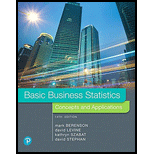
Concept explainers
Given the following

a. Compute the expected value for each distribution.
b. Compute the standard deviation for each distribution.
c. What is the probability that x will be at least 3 in Distribution A and Distribution B?
d. Compare the results of distributions A and B.
a.
Find the expected value for distribution A and distribution B.
Answer to Problem 1PS
The expected value of distribution A is 1, and distribution B is 3.
Explanation of Solution
Calculation:
The table of probability distributions for distribution A and B is given.
The formula for calculating expected value is
Here,
The expected value of distribution A is calculated by substituting the values in the above formula. It is calculated as,
The expected value of distribution B is
Thus, the expected value of distribution A and distribution B are 1 and 3, respectively.
b.
Find the standard deviation of distribution A and B.
Answer to Problem 1PS
The standard deviation for both distribution A and B is 1.22474.
Explanation of Solution
Calculation:
The standard deviation is calculated using the formula,
Here,
For distribution A,
For distribution B,
Thus, the standard deviation of distribution A and B is same, that is, 1.2247.
d.
Compare the results of the two distributions.
Answer to Problem 1PS
The mean value for distribution B is higher than distribution A but the standard deviation is same for both the distributions.
Explanation of Solution
From part a, the expected value for distribution A and B are obtained as 1 and 3, respectively. From part b, the standard deviation for both the distributions is obtained as 1.2247.
Thus, it can be said that the mean value or the expected value of distribution B is greater than that of distribution A. However, both of them have the same spread as the value of standard deviation is same.
Want to see more full solutions like this?
Chapter 5 Solutions
EBK BASIC BUSINESS STATISTICS
Additional Math Textbook Solutions
APPLIED STAT.IN BUS.+ECONOMICS
Introductory Statistics
Calculus for Business, Economics, Life Sciences, and Social Sciences (14th Edition)
Elementary Statistics: Picturing the World (7th Edition)
Finite Mathematics for Business, Economics, Life Sciences and Social Sciences
Intermediate Algebra (13th Edition)
- A company found that the daily sales revenue of its flagship product follows a normal distribution with a mean of $4500 and a standard deviation of $450. The company defines a "high-sales day" that is, any day with sales exceeding $4800. please provide a step by step on how to get the answers in excel Q: What percentage of days can the company expect to have "high-sales days" or sales greater than $4800? Q: What is the sales revenue threshold for the bottom 10% of days? (please note that 10% refers to the probability/area under bell curve towards the lower tail of bell curve) Provide answers in the yellow cellsarrow_forwardFind the critical value for a left-tailed test using the F distribution with a 0.025, degrees of freedom in the numerator=12, and degrees of freedom in the denominator = 50. A portion of the table of critical values of the F-distribution is provided. Click the icon to view the partial table of critical values of the F-distribution. What is the critical value? (Round to two decimal places as needed.)arrow_forwardA retail store manager claims that the average daily sales of the store are $1,500. You aim to test whether the actual average daily sales differ significantly from this claimed value. You can provide your answer by inserting a text box and the answer must include: Null hypothesis, Alternative hypothesis, Show answer (output table/summary table), and Conclusion based on the P value. Showing the calculation is a must. If calculation is missing,so please provide a step by step on the answers Numerical answers in the yellow cellsarrow_forward
 Glencoe Algebra 1, Student Edition, 9780079039897...AlgebraISBN:9780079039897Author:CarterPublisher:McGraw Hill
Glencoe Algebra 1, Student Edition, 9780079039897...AlgebraISBN:9780079039897Author:CarterPublisher:McGraw Hill
 Holt Mcdougal Larson Pre-algebra: Student Edition...AlgebraISBN:9780547587776Author:HOLT MCDOUGALPublisher:HOLT MCDOUGAL
Holt Mcdougal Larson Pre-algebra: Student Edition...AlgebraISBN:9780547587776Author:HOLT MCDOUGALPublisher:HOLT MCDOUGAL



